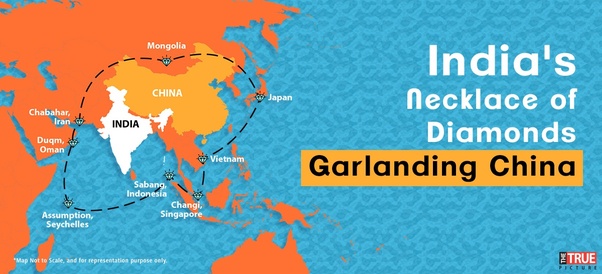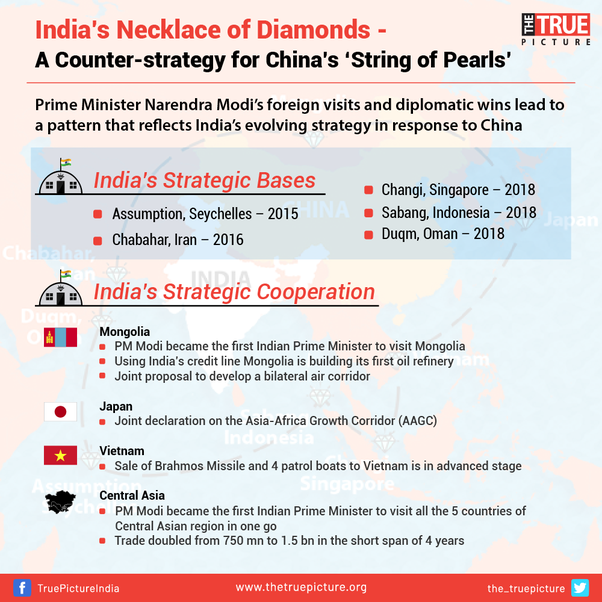What is India's Necklace of diamonds strategy?
First of all, What is China’s String of Pearls?
According to experts, it is an attempt by China to encircle India through maintaining and developing its strategic bases in countries around India, such as Pakistan, Maldives, Myanmar among others which will help in confining India to its own land and limiting its influence on the neighbouring countries. This also provides China with an easy access and control over the vast Indian ocean. Interestingly, even when China continued to pursue this strategy, however unofficially, previous government of India had no reply to it.
This string of pearls phenomena in the background of recent Chinese ‘One Belt One Road’ strategy has got a further boost as China is now not only focussing on countries around India but going further to Central Asia and Africa.
India’s Necklace of Diamonds
Some strategic experts have always talked about a potential necklace of diamonds (strategic bases) that India can use to garland China or deploy the very Chinese strategy of encirclement. They have even hailed it as India’s answer to China’s string of pearls. However, this looked like a distant reality a few years ago, but with the changing geo-strategic realities and a ‘power’ push from the top leadership of India in recent times, there is now a significant progress towards this seemingly distant goal.
India Building its Strategic Bases (Mining the Diamonds)
- Changi Naval Base, Singapore – Prime Minister Narendra Modi paved the way for signing of a significant agreement between India and Singapore which provided Indian Navy ‘direct’ access to this naval base. This is crucial as Indian navy ships can now not only refuel but even rearm while sailing through the South China Sea.
- Sabang Port, Indonesia – India got the military access to a strategic port like Sabang in 2018, located right at the entrance of one of world’s most famous choke point, Malacca Strait. This is one of the most significant agreements, as India now holds the strategic position in the Indian ocean through which large chunk of trade and crude oil passes on to China. Indian Naval ship INS Sumitra had visited Sabang Port recently.
- Duqm Port, Oman – India leveraging its rising status in the Indian Ocean gained strategic military access to this port in 2018, located on the south-eastern seaboard of Oman which protects Indian interests in the western theatre of the Indian Ocean, especially for facilitating India’s crude imports from the Persian Gulf. Moreover, it is now an Indian facility located right between the two important Chinese pearls (bases) Djibouti in Africa and Gwadar in Pakistan.
- Assumption Island, Seychelles – Overcoming the initial resistance, India is now developingthis naval base in Seychelles, first agreed in 2015. Both the countries have continued to work on the project which gives the military access to India. This particularly signifies India’s increasing strategic presence not only in Indian ocean but also in the African continent where China is desperately trying to penetrate through the maritime silk route.
- Chabahar Port, Iran – Prime Minister Narendra Modi signed the contract for development of this port in 2016. This port provides India access to Afghanistan and a precious trade route to Central Asia. In fact, India is reportedly about to begin operations at the Iranian port soon. This will give an unprecedented boost to India’s plan to increase its co-operation and contacts with Asian and Central Asian countries.
India Developing its Existing Strategic Assets (Polishing the Potential Diamonds)
Conclusion
After looking at all the facts, it can be said that India in recent times has worked incessantly towards asserting itself to achieve a better strategic cooperation with other countries. India’s recent policy shift from Non-Alignment to Multi-Alignment also reflects in the above discussion. India is not only developing the existing strategic bases (diamonds in its necklace) but also building newer bases, as well.
Further, India is fast developing routes to reach Central Asian countries. All the countries discussed above have shown great interests in connecting and working together with India. Some of them are cooperating with India to increase their trade relations, while others to maintain the ‘balance of power’ in specific regions.
Resultantly, an explicit pattern has emerged from India’s recent foreign policy pushes that India has befriended with almost all the countries in China’s periphery, and in the way, this is giving India the strategic access. This pattern can be seen in the necklace of diamonds that garlands China.
https://www.quora.com/What-is-Indias-Necklace-of-diamonds-strategy

